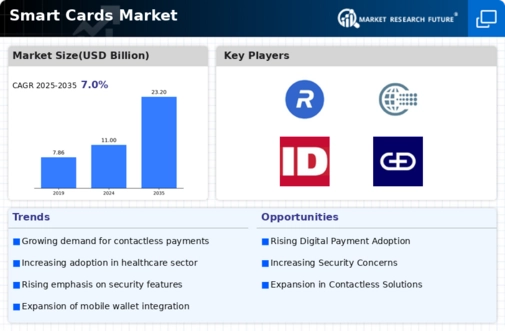Market Share
Smart Cards Market Share Analysis
In the competitive landscape of the Smart Cards market, market share positioning strategies play a pivotal role in determining the success of companies in this industry. One prevalent strategy is differentiation, where companies focus on creating unique and innovative features for their smart cards to distinguish themselves from competitors. This could include advanced security features, integration with emerging technologies, or design elements that cater to specific user preferences. By offering something distinct, companies aim to attract a niche market segment and secure a competitive advantage.
Another strategic approach in market share positioning is cost leadership. Some companies prioritize cost efficiency in the production of smart cards, allowing them to offer competitive pricing to customers. This strategy can be particularly effective in price-sensitive markets, where affordability is a significant factor influencing purchasing decisions. By capturing a larger customer base through competitive pricing, companies employing cost leadership strategies can strengthen their market share.
Partnerships and collaborations are also common strategies in the Smart Cards market. Companies often form alliances with other organizations, such as financial institutions, technology providers, or even government bodies. These partnerships can provide access to a broader customer base, distribution channels, or complementary technologies. Collaborative efforts can enhance a company's market share by leveraging the strengths of multiple entities to create comprehensive and mutually beneficial solutions.
Geographical expansion is a crucial market share positioning strategy for companies in the Smart Cards market. As the demand for smart cards continues to grow globally, companies strive to establish a strong presence in different regions. Expanding into new markets allows companies to tap into diverse consumer needs and preferences, adapt their products to local requirements, and gain a foothold in emerging economies with untapped potential.
Innovation and staying ahead in terms of technology is a fundamental strategy for market share positioning in the Smart Cards industry. Companies that invest in research and development to introduce cutting-edge technologies, such as biometric authentication, contactless capabilities, or IoT integration, can attract tech-savvy customers and gain a reputation for being at the forefront of innovation. Being the first to market with a groundbreaking feature can translate into a significant advantage in terms of market share.
Customer-centric strategies also play a crucial role in market share positioning. Companies that prioritize customer experience by offering user-friendly interfaces, efficient customer support, and customization options can build strong brand loyalty. Satisfied customers are more likely to remain loyal and recommend products to others, contributing to increased market share over time.
Acquisitions and mergers are strategic moves employed by some companies to enhance their market share. By acquiring or merging with other firms, companies can consolidate their resources, expand their product portfolios, and eliminate competitors. This strategic approach allows for a more significant market presence and increased bargaining power in negotiations with suppliers and customers.
Regulatory compliance and adherence to industry standards are essential aspects of market share positioning in the Smart Cards market. Companies that stay abreast of and comply with evolving regulations demonstrate reliability and trustworthiness to customers. This commitment to compliance can be a differentiating factor, particularly in industries where data security and privacy are paramount concerns.














Leave a Comment